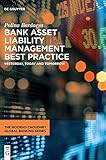Bank Asset Liability Management Best Practice : Yesterday, Today and Tomorrow / Polina Bardaeva.
Material type: TextSeries: The Moorad Choudhry Global Banking SeriesPublisher: Berlin ; Boston : De Gruyter, [2021]Copyright date: ©2021Description: 1 online resource (XIV, 155 p.)Content type:
TextSeries: The Moorad Choudhry Global Banking SeriesPublisher: Berlin ; Boston : De Gruyter, [2021]Copyright date: ©2021Description: 1 online resource (XIV, 155 p.)Content type: - 9783110666540
- 9783110666601
- 9783110669763
- online - DeGruyter
- Issued also in print.
| Item type | Current library | Call number | URL | Status | Notes | Barcode | |
|---|---|---|---|---|---|---|---|
 eBook
eBook
|
Biblioteca "Angelicum" Pont. Univ. S.Tommaso d'Aquino Nuvola online | online - DeGruyter (Browse shelf(Opens below)) | Online access | Not for loan (Accesso limitato) | Accesso per gli utenti autorizzati / Access for authorized users | (dgr)9783110669763 |
Frontmatter -- Acknowledgments -- Foreword -- Contents -- Preface -- Part 1: Historical Asset and Liability Management Concepts -- Introduction -- Chapter 1. Before the ALM Era -- Chapter 2. Financial Turbulence -- Chapter 3. Emergence of Derivatives -- Chapter 4. Regulators in Place -- Chapter 5. Preservation of Basel III Capital -- Chapter 6. Complete Interrelation -- Chapter 7. ALM Evolution Summary -- Conclusions -- Part 2: Place of Asset and Liability Management in a Bank -- Introduction -- Chapter 8. Prerequisites for ALM -- Chapter 9. ALM Responsibilities (Full Scope) -- Chapter 10. ALM Operating Model -- Chapter 11. ALM Inside a Risk Management Triangle -- Chapter 12. From a Standalone ALM Desk to a Group Treasury -- Conclusions -- Part 3: New Trends in Banking and Challenges for ALM -- Introduction -- Chapter 13. ALM Role in SREP -- Chapter 14. Scope of ALM Involvement for Different Banks -- Chapter 15. ALM Role in Crisis -- Chapter 16. After-Crisis ALM -- Selected Bibliography -- List of Figures -- List of Tables -- List of Abbreviations -- About the Author -- Index
restricted access online access with authorization star
http://purl.org/coar/access_right/c_16ec
As bankers incorporate more and more complicated and precise calculations and models, a solely mathematical approach will fail to confirm the viability of their business. This book explains how to combine ALM concepts with the emotional intelligence of managers in order to maintain the financial health of a bank, and quickly react to external environment challenges and banks’ microclimate changes. ALM embraces not only balance sheet targets setting, instruments and methodologies to achieve the targets, but also the correct and holistic understanding of processes that should be set up in a bank to prove its prudency and compliance with internal and external constraints, requirements and limitations and the ongoing continuity of its operations. Bank Asset Liability Management Best Practice delves into the philosophy of ALM, discusses the interrelation of processes inside the bank, and argues that every little change in one aspect of the bank processes has an impact on its other parts. The author discusses the changing role of ALM and its historical and current concepts, its strengths and weaknesses, and future threats and opportunities.
Issued also in print.
Mode of access: Internet via World Wide Web.
In English.
Description based on online resource; title from PDF title page (publisher's Web site, viewed 28. Feb 2023)


